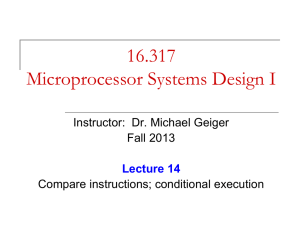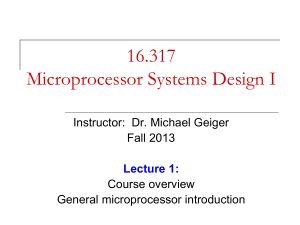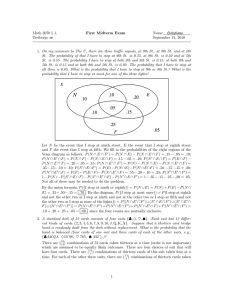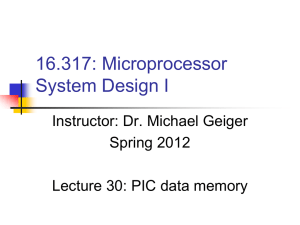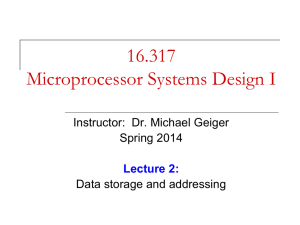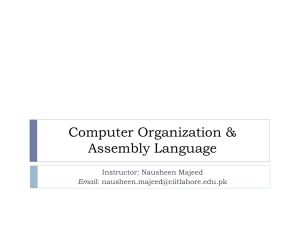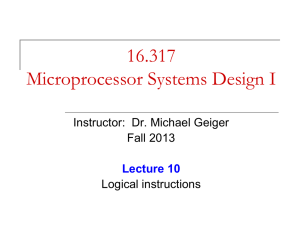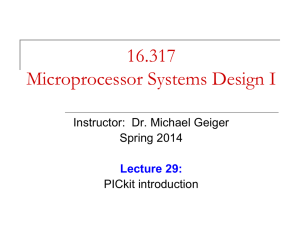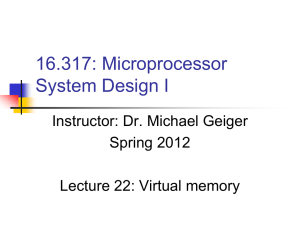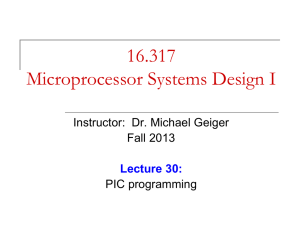PIC microcontroller overview
advertisement
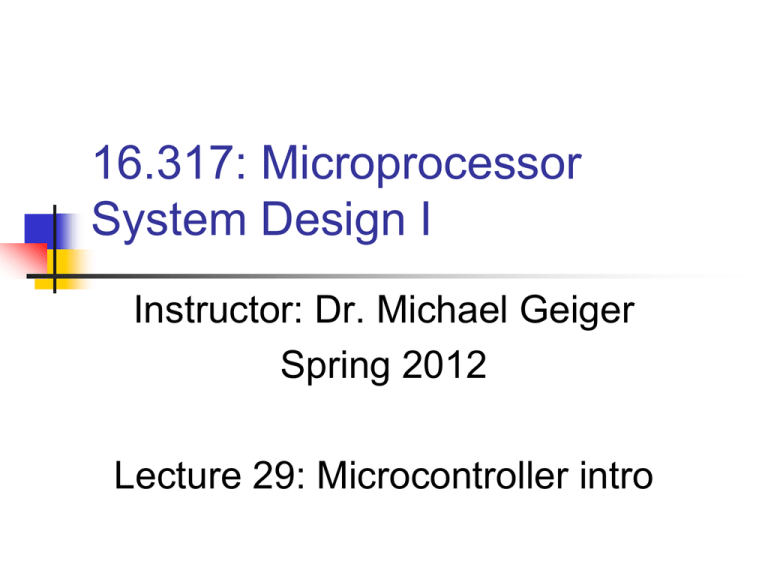
16.317: Microprocessor System Design I Instructor: Dr. Michael Geiger Spring 2012 Lecture 29: Microcontroller intro Lecture outline Announcements/reminders Lecture outline 4/9/2015 Lab 3 report due today Lab 4 to be posted today, due 4/25 HW 4 to be posted early next week Exam regrade requests due by Friday, 4/13 Microcontrollers PIC introduction Microprocessors I: Lecture 29 2 Overview of Microcontrollers Basically, a microcontroller is a device which integrates a number of the components of a microprocessor system onto a single microchip. Reference: http://mic.unn.ac.uk/miclearning/modules/micros/ch1/micro01notes.html#1.4 4/9/2015 Microprocessors I: Lecture 29 3 Microcontroller features Processor On-chip memory Usually general-purpose but can be app-specific Often RAM for data, EEPROM/Flash for code Integrated peripherals Common peripherals Special-purpose devices such as: 4/9/2015 Parallel I/O port(s) Clock generator(s) Timers/event counters Analog-to-digital converter (sensor inputs) Mixed signal components Serial port + other serial interfaces (SPI, USB) Ethernet Microprocessors I: Lecture 29 4 Microcontroller features Benefits Typically low-power/low-cost Easily programmable Simple ISAs (RISC processors) Use of development kits simplifies process Limitations 4/9/2015 Target for embedded applications Small storage space (registers, memory) Restricted instruction set May be required to multiplex pins Not typically used for high performance Microprocessors I: Lecture 29 5 PIC Microcontroller (PIC16F684) High performance, low cost, for embedded applications Low Power 4/9/2015 8.5uA @ 32KHz, 2.0V Peripheral Features Only 35 different instructions Interrupt capability Direct, indirect, relative addressing mode 12 I/O pins with individual direction control 10-bit A/D converter 8/16-bit timer/counter Special Microcontroller Features Internal/external oscillator Power saving sleep mode High Endurance Flash/EEPROM cell Microprocessors I: Lecture 29 6 PIC16F684 Block Diagram 4/9/2015 Microprocessors I: Lecture 29 7 PIC16F684 4/9/2015 12 pins, 2048 instructions, 128 byte variable memory, ADC, comparator, Timers, ICD Microprocessors I: Lecture 29 8 Harvard vs Von Neumann 4/9/2015 Organization of program and data memory Microprocessors I: Lecture 29 9 Program Memory Space 13-bit program counter to address 8K locations Each location is 14-bit wide (instructions are 14 bits long) RESET vector is 0000h Interrupt Vector is 0004h 4/9/2015 When the CPU is reset, its PC is automatically cleared to zero. 0004h is automatically loaded into the program counter when an interrupt occurs Vector address of code to be executed for given interrupt Microprocessors I: Lecture 29 10 Data Memory Space 4/9/2015 Microprocessors I: Lecture 29 11 Special Function Registers 4/9/2015 Microprocessors I: Lecture 29 12 Status Register 4/9/2015 Microprocessors I: Lecture 29 13 PCL and PCLATH 4/9/2015 PC: Program Counter, 13 bits PCL (02h): 8 bits, the lower 8 bits of PC PCLATH (0Ah): PC Latch, provides the upper 5 (or 2) bits of PC when PCL is written to 1st example: PC is loaded by writing to PCL 2nd example: PC is loaded during a CALL or GOTO instruciton Microprocessors I: Lecture 29 14 Stack 8-level deep x 13-bit wide hardware stack The stack space is not part of either program or data space and the stackpointer is not readable or writable. The PC is “PUSHed” onto the stack when a CALL instruction is executed, or an interrupt causes a branch. The stack is “POPed” in the event of a RETURN, RETLW or a RETFIE instruction execution. However, NO PUSH or POP instructions ! PCLATH is not affected by a “PUSH” or “POP” operation. The stack operates as a circular buffer: 4/9/2015 after the stack has been PUSHed eight times, the ninth push overwrites the value that was stored from the first push. Microprocessors I: Lecture 29 15 Next time 4/9/2015 Continue with discussion of PIC Microprocessors I: Lecture 29 16

